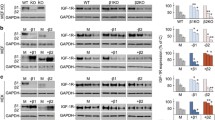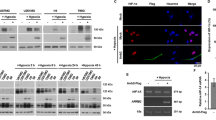Abstract
β-arrestins, including β-arrestin1 and β-arrestin2, are ubiquitous cytosolic proteins which localize in the cytoplasm and plasma membrane, initially be regarded as an potential character in G protein-coupled receptors (GPCR) desensitization, sequestration, and internalization. Besides, recent many studies increasingly revealed that β-arrestins served widely as versatile adapter proteins for scaffolding many intracellular signaling networks to modulate the strength and duration of signaling by diverse types of receptors and downstream kinases. As we known, the biologic and clinical behaviors of many tumors are largely determined by multiple molecular signal pathways. More recently, accumulating evidences established that β-arrestins got widely involved in many cancer developmental signaling events which responsible for tumor viability and metastasis, suggesting an impressive role of β-arrestins in tumor progression. Because of the regulation and biological output of β-arrestins is so complex, the role of β-arrestins in cancer development still remains enigmatic. However, the further understanding with the clinical prognosis and oncogenic potential of β-arrestins might facilitate the identification of diagnosis biomarkers and development of drug targets in cancer. In this article, we reviewed a comprehensive summary of the β-arrestins-mediated functions in human cancers.

Similar content being viewed by others
Abbreviations
- GPCRs:
-
G protein coupled receptors
- GRKs:
-
G protein-coupled receptor kinases
- TGF-β:
-
Transforming growth factor β
- MAPK:
-
Mitogen activated protein kineases
- PI3 K:
-
Phosphati dylinosito 3 kinase
- ERK:
-
Extracellular regulated protein kinases
- NSCLC:
-
Non small cell lung cancer
- TβRIII:
-
The type III TGF- β receptor
- COX-2:
-
Cyclooxygenase-2
- PGE2 :
-
Prostaglandin E2
- EP4 :
-
Prostanoid receptor
- E2F1:
-
E2F transcription factor 1
- CXCR4:
-
Chemokine(C-X-C motif) receptor 4
- EGFR:
-
Epithelial growth factor receptor
- ETAR:
-
Endothelin A receptor
- ET-1:
-
Endothelin-1
- EMT:
-
Epithelia to mesenchynal transition
- GSK-3β:
-
Glycogen synthase kinase 3β
- TP-β:
-
Thromboxane receptor β
- AR:
-
Androgen receptor
- PSA:
-
Prostate specific antigen
- LPA:
-
Lysopho sphatidic acid
- LPA1-3:
-
The type 1-3 lysophosphatidic acid receptor
- NES:
-
Nuclear export signal
References
Kovacs JJ, Hara MR, Davenport CL, Kim J, Lefkowitz RJ (2009) Arrestin development: emerging roles for beta-arrestins in developmental signaling pathways. Dev Cell 17:443–458
Luttrell LM, Lefkowitz RJ (2002) The role of beta-arrestins in the termination and transduction of G-protein-coupled receptor signals. J Cell Sci 115:455–465
Gurevich EV, Gurevich VV (2006) Arrestins: ubiquitous regulators of cellular signaling pathways. Genome Biol 7:236
Lefkowitz RJ, Whalen EJ (2004) Beta-arrestins: traffic cops of cell signaling. Curr Opin Cell Biol 16:162–168
Marchese A, Chen C, Kim YM, Benovic JL (2003) The ins and outs of G protein-coupled receptor trafficking. Trends Biochem Sci 28:369–376
Laporte SA, Oakley RH, Holt JA, Barak LS, Caron MG (2000) The interaction of beta-arrestin with the AP-2 adaptor is required for the clustering of beta 2-adrenergic receptor into clathrin-coated pits. J Biol Chem 275:23120–23126
Prossnitz ER (2004) Novel roles for arrestins in the post-endocytic trafficking of G protein-coupled receptors. Life Sci 75:893–899
Claing A, Laporte SA, Caron MG, Lefkowitz RJ (2002) Endocytosis of G protein-coupled receptors: roles of G protein-coupled receptor kinases and beta-arrestin proteins. Prog Neurobiol 66:61–79
Chun KS, Lao HC, Trempus CS, Okada M, Langenbach R (2009) The prostaglandin receptor EP2 activates multiple signaling pathways and beta-arrestin1 complex formation during mouse skin papilloma development. Carcinogenesis 30:1620–1627
Alvarez CJ, Lodeiro M, Theodoropoulou M, Camina JP, Casanueva FF, Pazos Y (2009) Obestatin stimulates Akt signalling in gastric cancer cells through beta-arrestin-mediated epidermal growth factor receptor transactivation. Endocr Relat Cancer 16:599–611
Rosano L, Cianfrocca R, Masi S, Spinella F, Di Castro V, Biroccio A et al (2009) Beta-arrestin links endothelin A receptor to beta-catenin signaling to induce ovarian cancer cell invasion and metastasis. Proc Natl Acad Sci USA 106:2806–2811
Bryja V, Gradl D, Schambony A, Arenas E, Schulte G (2007) Beta-arrestin is a necessary component of Wnt/beta-catenin signaling in vitro and in vivo. Proc Natl Acad Sci USA 104:6690–6695
Bryja V, Schambony A, Cajanek L, Dominguez I, Arenas E, Schulte G (2008) Beta-arrestin and casein kinase 1/2 define distinct branches of non-canonical WNT signalling pathways. EMBO Rep 9:1244–1250
Mukherjee A, Veraksa A, Bauer A, Rosse C, Camonis J, Artavanis-Tsakonas S (2005) Regulation of Notch signalling by non-visual beta-arrestin. Nat Cell Biol 7:1191–1201
Luan B, Zhao J, Wu H, Duan B, Shu G, Wang X et al (2009) Deficiency of a beta-arrestin-2 signal complex contributes to insulin resistance. Nature 457:1146–1149
Tohgo A, Choy EW, Gesty-Palmer D, Pierce KL, Laporte S, Oakley RH et al (2003) The stability of the G protein-coupled receptor-beta-arrestin interaction determines the mechanism and functional consequence of ERK activation. J Biol Chem 278:6258–6267
Wilbanks AM, Fralish GB, Kirby ML, Barak LS, Li YX, Caron MG (2004) Beta-arrestin 2 regulates zebrafish development through the hedgehog signaling pathway. Science 306:2264–2267
Finger EC, Lee NY, You HJ, Blobe GC (2008) Endocytosis of the type III transforming growth factor-beta (TGF-beta) receptor through the clathrin-independent/lipid raft pathway regulates TGF-beta signaling and receptor down-regulation. J Biol Chem 283:34808–34818
Mythreye K, Blobe GC (2009) The type III TGF-beta receptor regulates epithelial and cancer cell migration through beta-arrestin2-mediated activation of Cdc42. Proc Natl Acad Sci USA 106:8221–8226
You HJ, How T, Blobe GC (2009) The type III transforming growth factor-beta receptor negatively regulates nuclear factor kappa B signaling through its interaction with beta-arrestin2. Carcinogenesis 30:1281–1287
Luttrell LM, Ferguson SS, Daaka Y, Miller WE, Maudsley S, Della RG et al (1999) Beta-arrestin-dependent formation of beta2 adrenergic receptor-Src protein kinase complexes. Science 283:655–661
Krysan K, Reckamp KL, Dalwadi H, Sharma S, Rozengurt E, Dohadwala M et al (2005) Prostaglandin E2 activates mitogen-activated protein kinase/Erk pathway signaling and cell proliferation in non-small cell lung cancer cells in an epidermal growth factor receptor-independent manner. Cancer Res 65:6275–6281
Zhang Y, Liu Q, Zhang M, Yu Y, Liu X, Cao X (2009) Fas signal promotes lung cancer growth by recruiting myeloid-derived suppressor cells via cancer cell-derived PGE2. J Immunol 182:3801–3808
Alaa M, Suzuki M, Yoshino M, Tian L, Suzuki H, Nagato K et al (2009) Prostaglandin E2 receptor 2 overexpression in squamous cell carcinoma of the lung correlates with p16INK4A methylation and an unfavorable prognosis. Int J Oncol 34:805–812
Zheng Y, Ritzenthaler JD, Sun X, Roman J, Han S (2009) Prostaglandin E2 stimulates human lung carcinoma cell growth through induction of integrin-linked kinase: the involvement of EP4 and Sp1. Cancer Res 69:896–904
Zhu YM, Azahri NS, Yu DC, Woll PJ (2008) Effects of COX-2 inhibition on expression of vascular endothelial growth factor and interleukin-8 in lung cancer cells. BMC Cancer 8:218
Yang L, Huang Y, Porta R, Yanagisawa K, Gonzalez A, Segi E et al (2006) Host and direct antitumor effects and profound reduction in tumor metastasis with selective EP4 receptor antagonism. Cancer Res 66:9665–9672
Kim JI, Lakshmikanthan V, Frilot N, Daaka Y (2010) Prostaglandin E2 promotes lung cancer cell migration via EP4-betaArrestin1-c-Src signalsome. Mol Cancer Res 8:569–577
Dasgupta P, Rizwani W, Pillai S, Davis R, Banerjee S, Hug K et al (2011) ARRB1-mediated regulation of E2F target genes in nicotine-induced growth of lung tumors. J Natl Cancer Inst 103:317–333
Raghuwanshi SK, Nasser MW, Chen X, Strieter RM, Richardson RM (2008) Depletion of beta-arrestin-2 promotes tumor growth and angiogenesis in a murine model of lung cancer. J Immunol 180:5699–5706
Zhang L, Conejo-Garcia JR, Katsaros D, Gimotty PA, Massobrio M, Regnani G et al (2003) Intratumoral T cells, recurrence, and survival in epithelial ovarian cancer. N Engl J Med 348:203–213
Buchanan FG, Gorden DL, Matta P, Shi Q, Matrisian LM, DuBois RN (2006) Role of beta-arrestin 1 in the metastatic progression of colorectal cancer. Proc Natl Acad Sci USA 103:1492–1497
Rosano L, Spinella F, Di Castro V, Nicotra MR, Dedhar S, de Herreros AG et al (2005) Endothelin-1 promotes epithelial-to-mesenchymal transition in human ovarian cancer cells. Cancer Res 65:11649–11657
Dong M, How T, Kirkbride KC, Gordon KJ, Lee JD, Hempel N et al (2007) The type III TGF-beta receptor suppresses breast cancer progression. J Clin Invest 117:206–217
Turley RS, Finger EC, Hempel N, How T, Fields TA, Blobe GC (2007) The type III transforming growth factor-beta receptor as a novel tumor suppressor gene in prostate cancer. Cancer Res 67:1090–1098
Gordon KJ, Dong M, Chislock EM, Fields TA, Blobe GC (2008) Loss of type III transforming growth factor beta receptor expression increases motility and invasiveness associated with epithelial to mesenchymal transition during pancreatic cancer progression. Carcinogenesis 29:252–262
Amling CL (2001) Diagnosis and management of superficial bladder cancer. Curr Probl Cancer 25:219–278
Kelley-Hickie LP, Kinsella BT (2006) Homologous desensitization of signalling by the beta (beta) isoform of the human thromboxane A2 receptor. Biochim Biophys Acta 1761:1114–1131
Moussa O, Ashton AW, Fraig M, Garrett-Mayer E, Ghoneim MA, Halushka PV et al (2008) Novel role of thromboxane receptors beta isoform in bladder cancer pathogenesis. Cancer Res 68:4097–4104
Feldman BJ, Feldman D (2001) The development of androgen-independent prostate cancer. Nat Rev Cancer 1:34–45
Lakshmikanthan V, Zou L, Kim JI, Michal A, Nie Z, Messias NC et al (2009) Identification of betaArrestin2 as a corepressor of androgen receptor signaling in prostate cancer. Proc Natl Acad Sci USA 106:9379–9384
Lin HK, Wang L, Hu YC, Altuwaijri S, Chang C (2002) Phosphorylation-dependent ubiquitylation and degradation of androgen receptor by Akt require Mdm2 E3 ligase. EMBO J 21:4037–4048
Boucharaba A, Serre CM, Guglielmi J, Bordet JC, Clezardin P, Peyruchaud O (2006) The type 1 lysophosphatidic acid receptor is a target for therapy in bone metastases. Proc Natl Acad Sci USA 103:9643–9648
Hao F, Tan M, Xu X, Han J, Miller DD, Tigyi G et al (2007) Lysophosphatidic acid induces prostate cancer PC3 cell migration via activation of LPA(1), p42 and p38alpha. Biochim Biophys Acta 1771:883–892
Li TT, Alemayehu M, Aziziyeh AI, Pape C, Pampillo M, Postovit LM et al (2009) Beta-arrestin/Ral signaling regulates lysophosphatidic acid-mediated migration and invasion of human breast tumor cells. Mol Cancer Res 7:1064–1077
Zhao M, Zhou G, Zhang Y, Chen T, Sun X, Stuart C et al (2009) beta-arrestin2 inhibits opioid-induced breast cancer cell death through Akt and caspase-8 pathways. Neoplasma 56:108–113
Lundgren K, Tobin NP, Lehn S, Stal O, Ryden L, Jirstrom K et al (2011) Stromal expression of beta-arrestin-1 predicts clinical outcome and tamoxifen response in breast cancer. J Mol Diagn 13:340–351
Scott MG, Le Rouzic E, Perianin A, Pierotti V, Enslen H, Benichou S et al (2002) Differential nucleocytoplasmic shuttling of beta-arrestins. Characterization of a leucine-rich nuclear export signal in beta-arrestin2. J Biol Chem 277:37693–37701
Wang P, Wu Y, Ge X, Ma L, Pei G (2003) Subcellular localization of beta-arrestins is determined by their intact N domain and the nuclear export signal at the C terminus. J Biol Chem 278:11648–11653
Kang J, Shi Y, Xiang B, Qu B, Su W, Zhu M et al (2005) A nuclear function of beta-arrestin1 in GPCR signaling: regulation of histone acetylation and gene transcription. Cell 123:833–847
Acknowledgments
This work was supported by grants from National Natural Science Foundation of China (No. 30973543, No. 81173075), Specialized Research Fund for the Doctoral Program of Higher Education of China (No. 20113420120002), Natural Science Foundation of the Higher Education Institutions of Anhui Province (No. KJ2012A153).
Author information
Authors and Affiliations
Corresponding author
Rights and permissions
About this article
Cite this article
Hu, S., Wang, D., Wu, J. et al. Involvement of β-arrestins in cancer progression. Mol Biol Rep 40, 1065–1071 (2013). https://doi.org/10.1007/s11033-012-2148-0
Received:
Accepted:
Published:
Issue Date:
DOI: https://doi.org/10.1007/s11033-012-2148-0




